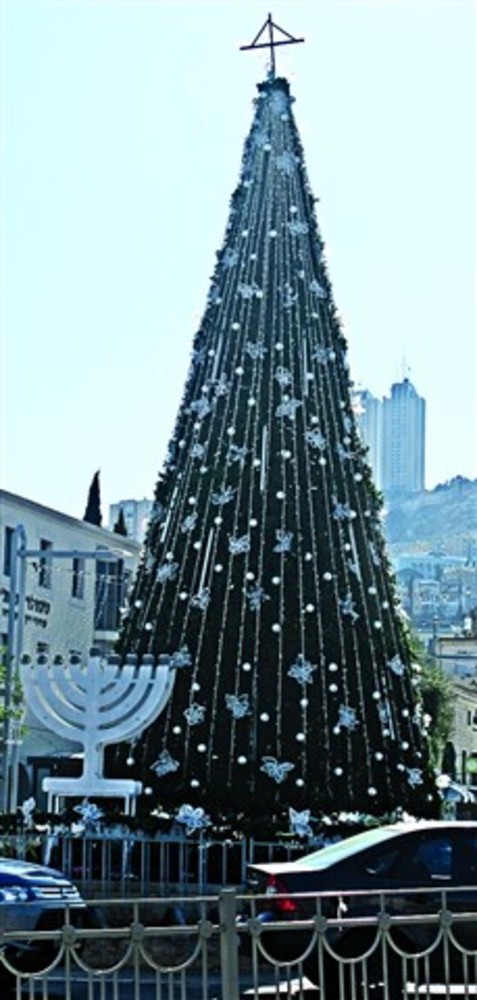Coexisting cultures make for fascinating holidays
 UNESCO Square for Tolerance and Peace.While this holiday season didn’t resemble the traditions of my youth, it was still very special for me. With my new friends and communities here in Israel, I took part in multicultural celebrations across the country. The saying here goes that Israelis will take any excuse to celebrate, eat, drink and be merry with the ones they love ... and especially without the bombardment of superficial, commercial holiday stresses, why not?
UNESCO Square for Tolerance and Peace.While this holiday season didn’t resemble the traditions of my youth, it was still very special for me. With my new friends and communities here in Israel, I took part in multicultural celebrations across the country. The saying here goes that Israelis will take any excuse to celebrate, eat, drink and be merry with the ones they love ... and especially without the bombardment of superficial, commercial holiday stresses, why not?
In past years on Hanukkah, my family and I lit candles and exchanged gifts. I remember dreidels, latkes and chocolate gelt sales and displays becoming more and more aggressive in our local markets. This year, I celebrated in Israel, where all of the holidays seem much less commercialized. Even a holiday like Hanukkah seemed hardly present (no pun intended), save for the three days off from school and the overflowing abundance of freshly baked jelly doughnuts. When I did spend one special evening sharing a holiday meal with a soldier friend and her family, it far exceeded America’s month (or more) of in-your-face advertisements and pressures for holiday shopping.
Just after Christmas, I caught a train to Haifa. There I was able to see the last of the annual “Holiday of Holiday’s” celebration, where, for two weeks, festivities and special events occur throughout the city’s museums, restaurants and streets. Despite the many ticketed events available, I spent my weekend visiting the public celebrations and sites, exploring the beautiful landscape, architecture and little pockets of art and nature scattered across the city’s mountainside.
Though Israel is most often recognized for its Jewish population, in Haifa I found many Christian, Jewish and Muslim symbols, not to mention the breathtaking Baha’i Gardens. When I came upon the “UNESCO Square for Tolerance and Peace,” I could feel what a powerful and extraordinary promotion the site represents for the peaceful coexistence of these overlapping religious populations.
Haifa’s multiculturalism was also apparent as I moseyed through the large crowds of people, ducked in and out of shops, and watched the festival’s daily mid-afternoon parade of soldiers, students and Santas. Every day, the streets were filled with the smoke and smells of cooked treats, many of which I didn’t recognize. The few colorful stands of popcorn and cotton candy seemed all too American in the midst of the now commonplace falafel and humus vendors.
The “Holiday of Holidays” usually spans Hanukkah, Id al-Adha, and Christmas, although my friends and I visited Tel-Aviv for the latter. I had not expected much to be seen; I was, after all, living in the Jewish State. There was the occasional decorated window, a few pedestrians wearing Santa hats ... and that was about it. As we found out, Christmas festivities are mostly reserved for New Year’s Eve, which Israelis call “Sylvester.” The history of this day is complex for Jews, but the opportunity for a celebration was certainly seized in Tel-Aviv.
So, my friends and I returned here for New Year’s Eve, and the bars and clubs were overflowing. We journeyed in and out of different venues, and when midnight hit, we all turned to each other expecting the announcement. No one else looked up. No one seemed to notice the time, except for us. We shrugged and laughed, and agreed that this New Year’s (as opposed to that of the Jewish calendar) was truly just an excuse to party.
Reflecting on these holidays, I realize that I did miss seeing my family and old friends, to uphold the little traditions we had. Yet, I’m hopeful that this year’s experience of Israeli holiday culture is having a positive influence on me, one I can bring with me when I return. I am fascinated by this particular mix of secular and religious celebrations and the many coexisting cultures. It certainly sparks my curiosity about what other internationally significant days of gratitude for family, friends and “excuses to party” I’ve been missing.
CHLOE J. NEWMAN grew up in Providence, attended The Wheeler School and received a Bachelor of Fine Arts degree from Carnegie Mellon University in Pittsburgh. While currently volunteering in Israel, Chloe continues to pursue her career in the arts. Her trip was partially funded with a travel grant from the Salmanson Fund established at the Jewish Alliance of Greater R.I. and with funds accrued through the Gift of Israel program.







